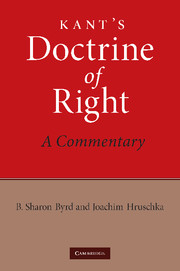Book contents
- Frontmatter
- Contents
- Introduction and methods of interpretation
- Chapter 1 The idea of the juridical state and the postulate of public law
- Chapter 2 The state of nature and the three leges
- Appendix to Chapter 2 Iustitia tutatrix, iustitia commutativa, and iustitia distributiva and their differences
- Chapter 3 The right to freedom
- Chapter 4 The permissive law in the Doctrine of Right
- Chapter 5 The external mine and thine
- Chapter 6 Intelligible possession of land
- Chapter 7 The “state in the idea”
- Chapter 8 The state in reality
- Chapter 9 International and cosmopolitan law
- Chapter 10 The “idea of public law” and its limits
- Chapter 11 Contract law I. Why must I keep my promise?
- Chapter 12 Contract law II. Kant's table of contracts
- Chapter 13 Criminal punishment
- Chapter 14 The human being as a person
- Appendix I to Chapter 14 On the logic of “‘ought’ implies ‘can’”
- Appendix II to Chapter 14 The system of rules of imputation
- Bibliography
- Index
Chapter 10 - The “idea of public law” and its limits
Published online by Cambridge University Press: 05 June 2012
- Frontmatter
- Contents
- Introduction and methods of interpretation
- Chapter 1 The idea of the juridical state and the postulate of public law
- Chapter 2 The state of nature and the three leges
- Appendix to Chapter 2 Iustitia tutatrix, iustitia commutativa, and iustitia distributiva and their differences
- Chapter 3 The right to freedom
- Chapter 4 The permissive law in the Doctrine of Right
- Chapter 5 The external mine and thine
- Chapter 6 Intelligible possession of land
- Chapter 7 The “state in the idea”
- Chapter 8 The state in reality
- Chapter 9 International and cosmopolitan law
- Chapter 10 The “idea of public law” and its limits
- Chapter 11 Contract law I. Why must I keep my promise?
- Chapter 12 Contract law II. Kant's table of contracts
- Chapter 13 Criminal punishment
- Chapter 14 The human being as a person
- Appendix I to Chapter 14 On the logic of “‘ought’ implies ‘can’”
- Appendix II to Chapter 14 The system of rules of imputation
- Bibliography
- Index
Summary
Kant contrasts commutative to distributive justice twice in the Doctrine of Right, once expressly using these terms in discussing a group of “four cases” and once in connection with equity, where he speaks of “equity,” meaning commutative, and of “law in the proper sense (strict law),” meaning distributive, justice. The four cases involve (1) a gratuitous promise, (2) a lending agreement, (3) a good faith purchase of stolen goods, and (4) a court placing a witness under oath. These cases all illustrate implementation of the “Idea of Public Law.” When Kant considers the equity cases (the trading company and the domestic servant cases) he does so in combination with a necessity case to indicate that the idea of public law requires sacrifice. There are “rights that have no judge,” rights that cannot have any judge.
In this chapter, we first review Kant's terminology for commutative and distributive justice (section 1). This review leads into our analysis of the four cases. We show that the four cases lay the foundation for the three institutions of protective, mutually acquiring, and distributive justice in a juridical state (section 2). Finally, we provide an overview of Kant's ideas on rights that have no judge. This overview explains his equity, necessity, infanticide, and dueling cases (section 3).
Kant's terminology on the distinction between commutative and distributive justice
The distinction between commutative and distributive justice provides the key to understanding the four cases. Kant employs Hobbes' definitions of these two types of justice. Commutative justice is the justice of the individual market participant, who determines what is “right” (recht) in a concrete case by reaching his own “private” judgment. In contrast, distributive justice is the justice of the public judiciary in a juridical state, which determines what is “established as right” (Rechtens) by reaching its “public” judgments.
- Type
- Chapter
- Information
- Kant's Doctrine of RightA Commentary, pp. 215 - 231Publisher: Cambridge University PressPrint publication year: 2010



